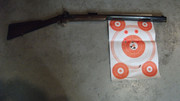Well Troll, you can disagree all you want, and it is very unlikely you will change my mind on the subject, and I am certainly not trying to change your mind, heck, I don't even know you, but I do admire your spirit.
Looks to me like you made my point for me.....I don't have any idea what "premeasured" means to you. Was that weighed or volume "pre" measured?
However,,, Looks like the weighed (weighed?) group is the better group. Right? That's what I said, best consistency would be weighing..
The entire spread of all 9 of your balls balls is less than 6".
White tail is commonly stated to be a 6" kill zone, hereby recognized by all hunters as "minute of deer". Anything in the zone is an assured kill.
BTW, when I did the same thing, I shot at 75 meters (~82 yards) which is my average deer hunt with blackpowder and all (10) of mine were inside 3". 5 were weighed, 5 were measured by volume. The 5 shot with weight measured were a bit tighter group than the volume measured ones. Shot with a TC Hawken with a 32" Green Mountain barrel. Maybe you need to measure your powder like I do...
(I use a volume adjustable CVA with a barrel snout on it.)
I do not normally take the time to actually weigh black powder for short ranges of 100 or less. I do weight my powder to (+/-).05gr for 1K long range. (Not a muzzleloader). I can tell you for certain that as little as .1 grain variance at 1,000 yards will create a miss on a 6" target even in a still wind.
BTW, in case you don't believe that I can shoot a smoker that well, just ask, there are several here on this forum that have come out to the range with me for a morning of shooting.
But, it's all good no matter how you do it, the important thing is you are thinking and experimenting, and that makes you better.







